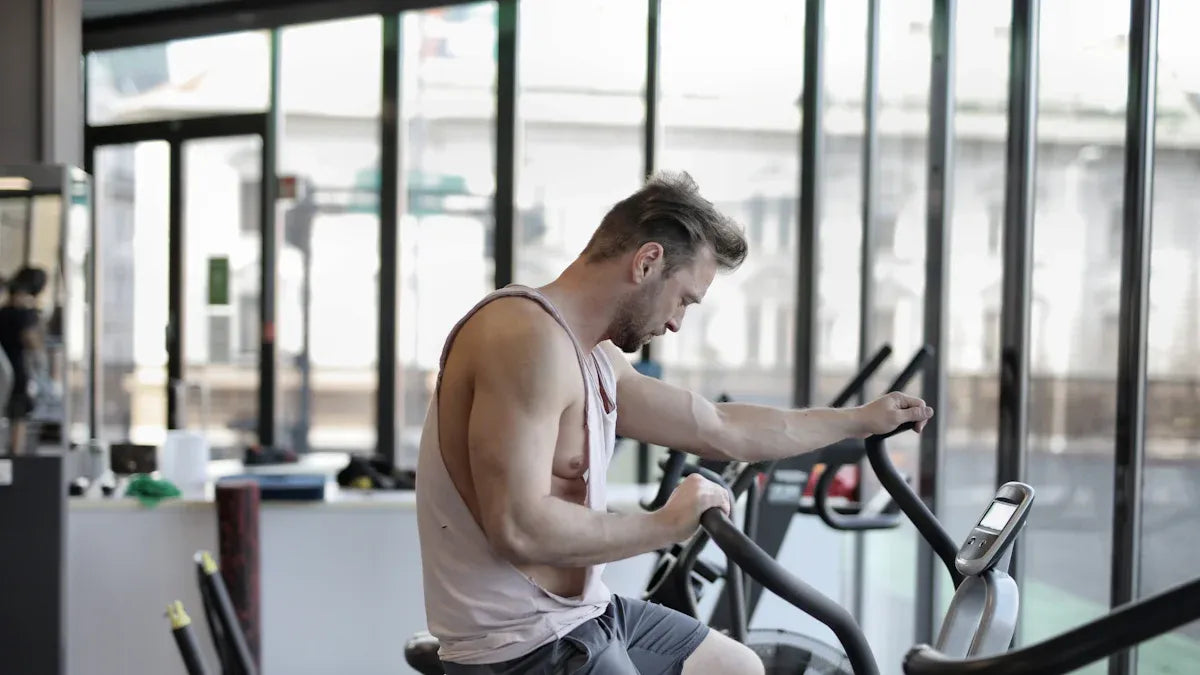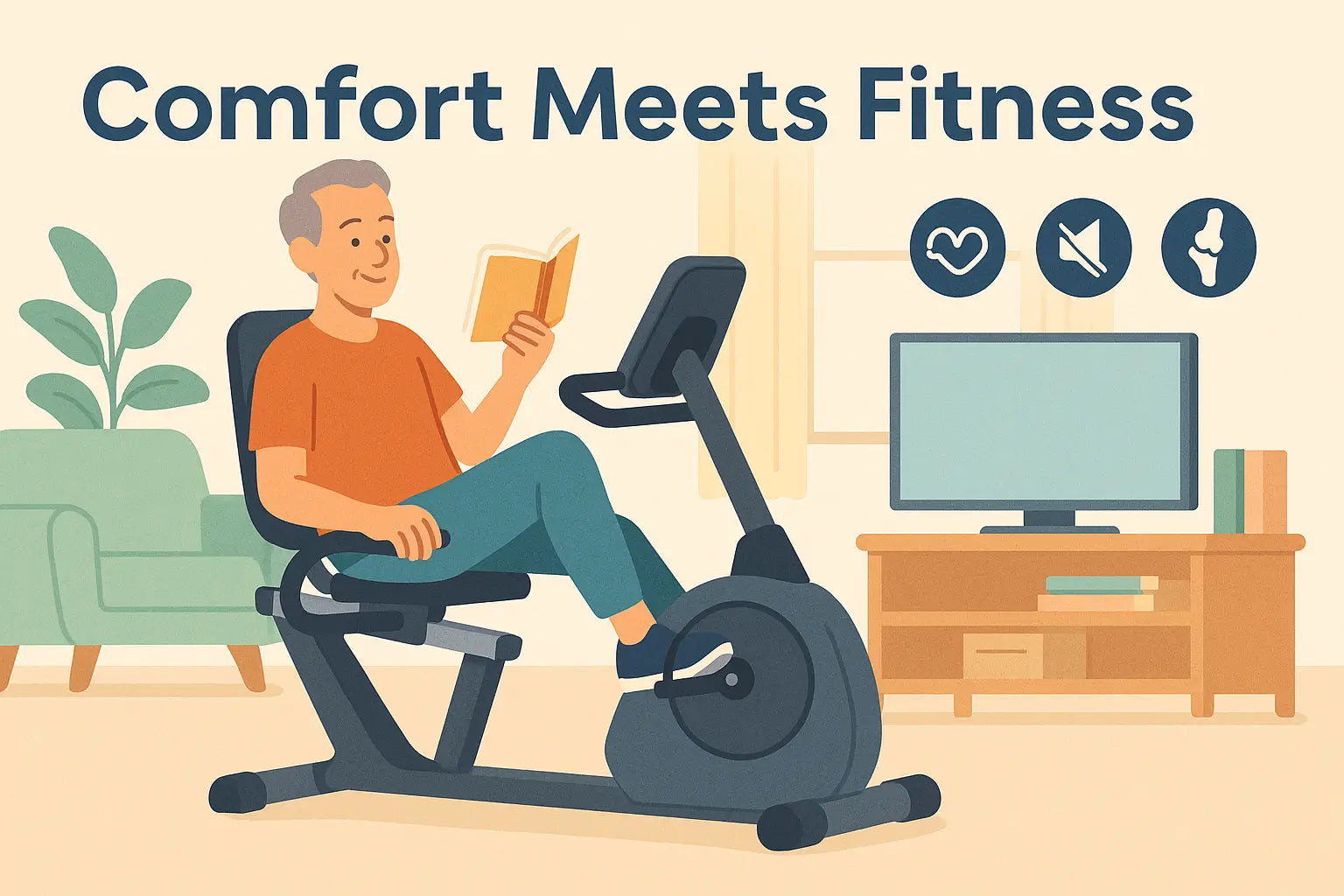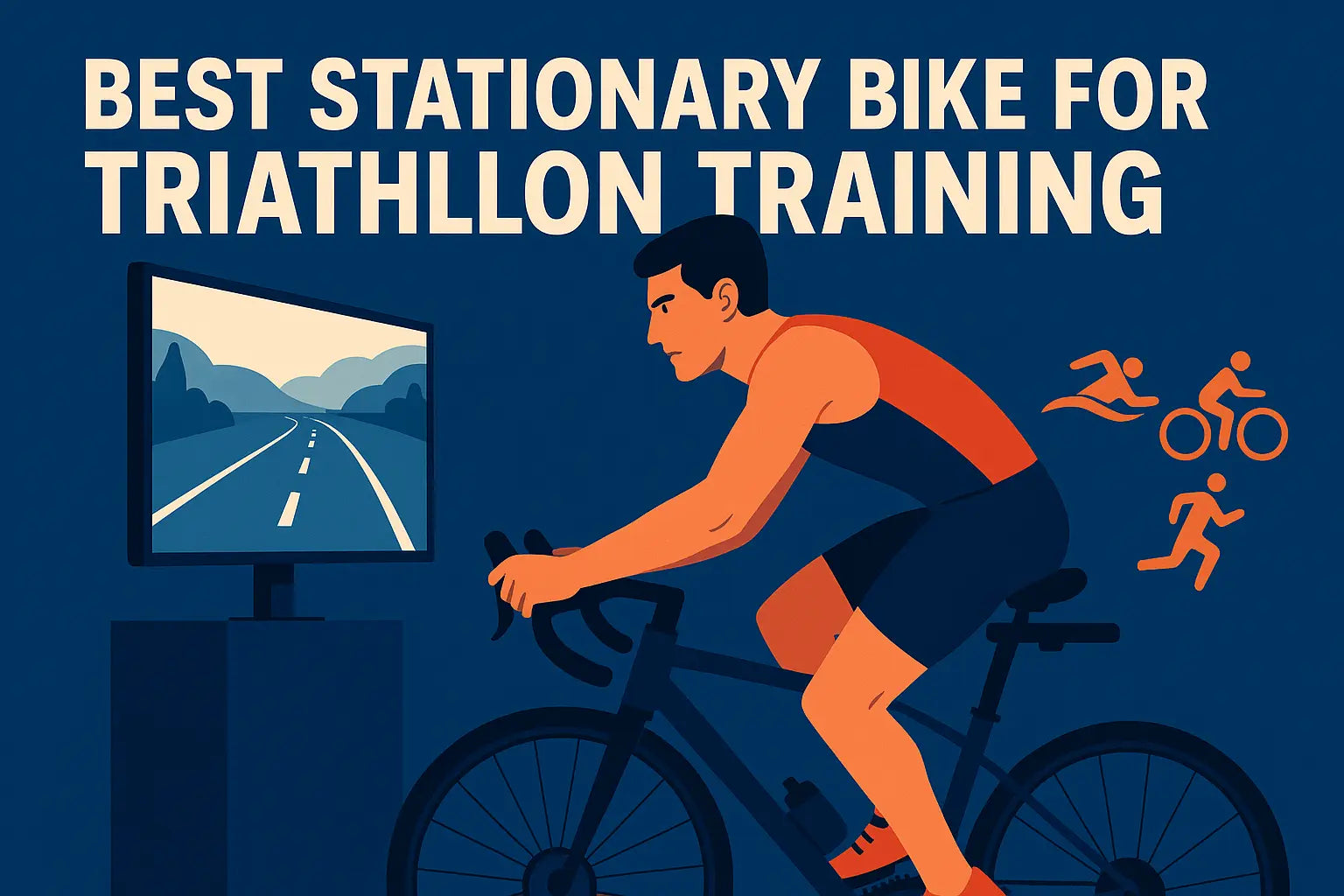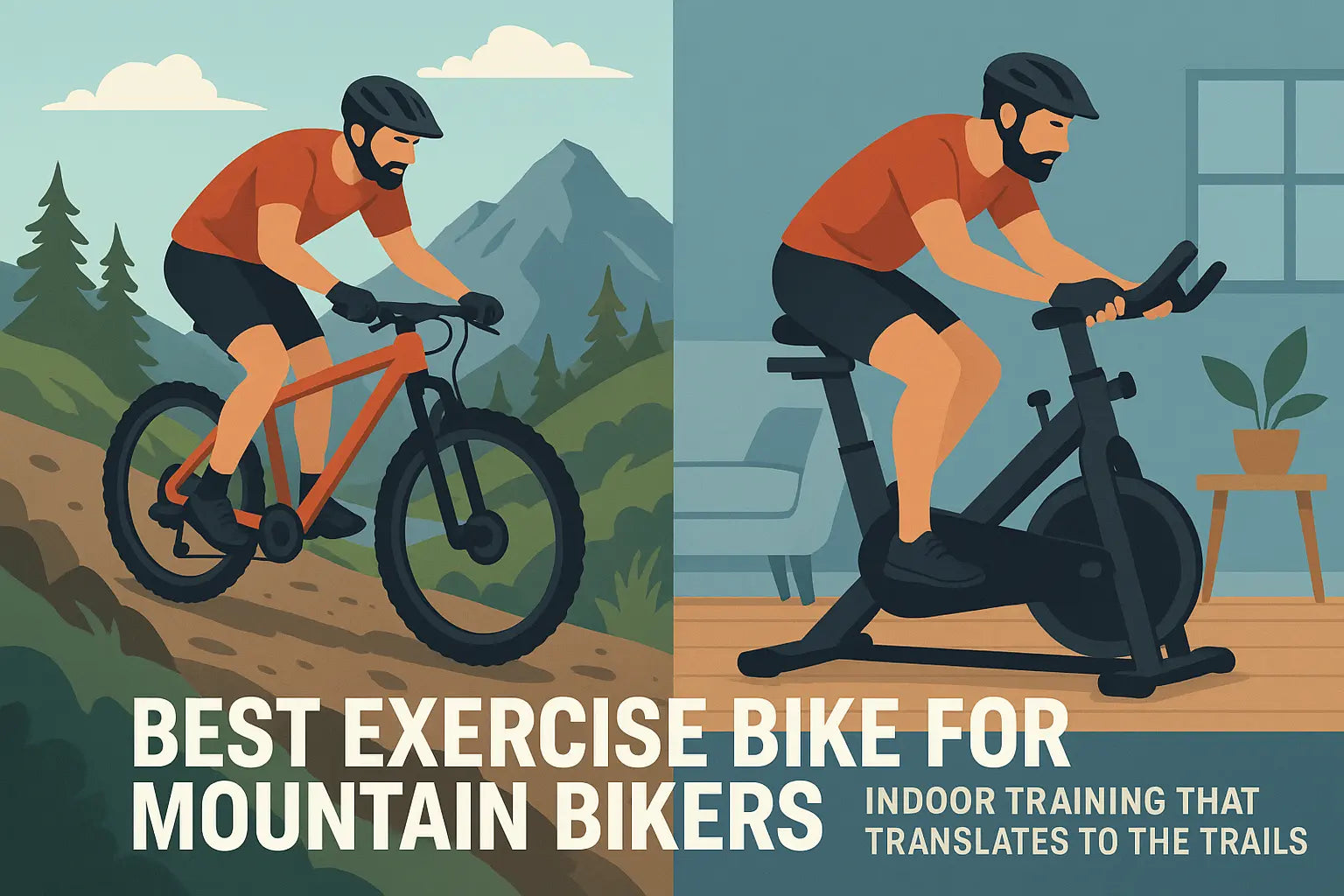If you struggle with lower back pain, a recumbent bike might help you exercise safely. The ergonomic seat and built-in lumbar support let you sit back and relax your spine. Many people find recumbent bikes gentle and effective. One clinical trial showed patients improved their pain and endurance after eight weeks of biking.
|
Study Type |
Participants |
Duration |
Key Findings |
|---|---|---|---|
|
Clinical trial |
50 adults |
8 weeks |
Less pain, better endurance, improved walking |
Always talk with your doctor before starting a new exercise routine.
Key Takeaways
-
Recumbent bikes provide excellent lumbar support, allowing you to exercise comfortably without straining your back.
-
These bikes offer a low-impact workout that reduces stress on your joints, making them ideal for seniors and those in rehabilitation.
-
Proper setup and posture on a recumbent bike can enhance comfort and safety, helping you avoid pain and injuries while exercising.
Recumbent Bike and Lower Back Pain
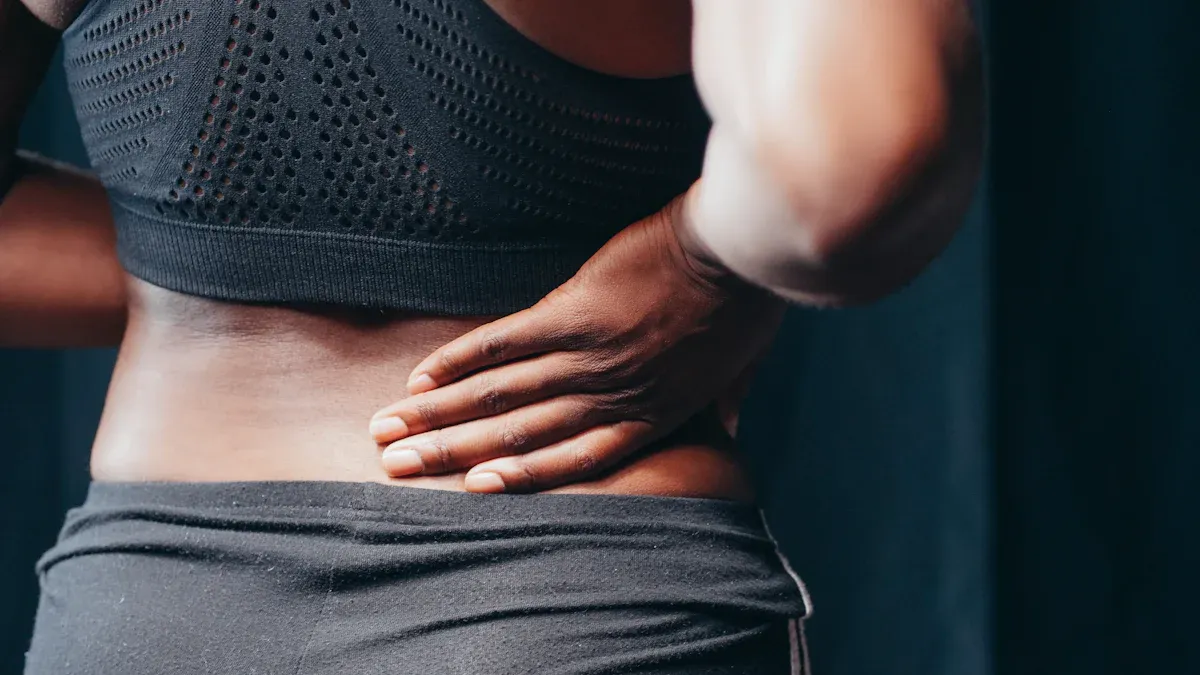
Lumbar Support
When you sit on a recumbent bike, you notice the difference right away. The seat feels wide and cushioned. Your back gets gentle support from the built-in backrest. This ergonomic design helps you relax your spine and keep a comfortable riding position. You do not have to hunch forward or balance on a small seat. Instead, you lean back and let the bike do the work for your lower back.
-
Recumbent bikes often come with extra-large seats that provide lumbar support.
-
The backrest keeps your lower back muscles from working too hard.
-
Many models, like the Performance Series Recumbent Bike, use a reclining seat for maximum comfort.
-
The design focuses on back support and proper spinal alignment, which is great for seniors and anyone in rehab or physical therapy.
You might find that recumbent biking feels easier on your body, especially if you have lower back pain. The support helps you stay active without making your pain worse.
Reduced Strain
A recumbent bike gives you a stable riding position. The reclined seat lets your back rest while your legs do the work. You do not need to worry about jarring movements or sudden twists. This low impact workout is gentle on your joints and helps you avoid extra stress on your spine.
-
The backrest supports your lower back and lets your muscles relax.
-
The reclined position encourages healthy spinal alignment and can open up space for nerve roots. This may help if you have herniated discs or spinal stenosis.
-
Recumbent bikes improve circulation, sending more oxygen and nutrients to your spine and muscles. This helps your body heal.
-
The smooth motion of pedaling keeps your workout gentle and safe, which is perfect for seniors or anyone with joint problems.
Recumbent bikes are designed to be gentler on back injuries. You get the benefits of exercise without risking more pain. Many physical therapy programs use recumbent bikes because they are safe and effective for people with lower back pain. If you want to stay active and protect your back, this type of bike is a smart choice.
Benefits of Recumbent Bikes

Comfort and Stability
You want a comfortable riding position when you deal with lower back pain. Recumbent bikes give you just that. The ergonomic design supports your body and helps you keep good spinal alignment. You sit back and relax, letting the wide seat and backrest hold you steady. This setup is great for seniors and anyone in rehab or physical therapy.
-
The stable riding position keeps you safe and balanced.
-
Rigid carbon steel frames absorb shocks and vibrations, so you feel less pain.
-
Nylon mesh seats spread your weight evenly and reduce pressure on sore spots.
-
You get more comfort and support than with upright bikes.
Recumbent biking feels gentle and secure. You do not have to worry about losing balance or straining your back. Many people find these bikes perfect for daily exercise, especially if you have joint problems or need extra stability.
Low-Impact Exercise
Recumbent bikes offer a low impact workout that protects your joints. You pedal in a reclined position, which helps your muscles move naturally. This motion keeps your knees, hips, and back safe. You can build strength and improve circulation without hurting yourself.
-
Recumbent bikes are great for seniors and people with mobility issues.
-
The forward pedal placement lets you move your legs easily.
-
You avoid stress on your joints while still getting a good cardiovascular workout.
-
Light resistance and slow pace work well for rehab and recovery.
Here’s a quick look at recommended session durations for different goals:
|
Goal |
Duration |
Frequency |
Notes |
|---|---|---|---|
|
Weight Loss |
30–60 minutes |
5–6 times per week |
Steady pace or interval training |
|
Cardiovascular Health |
20–30 minutes |
3–5 times per week |
Maintain moderate intensity (Zone 2) |
|
Rehab & Recovery |
10–20 minutes |
Daily or every other day |
Light resistance, slow pace |
|
Muscle Endurance |
25–45 minutes |
4–5 times per week |
Gradual resistance increase; focus on lower body muscles |
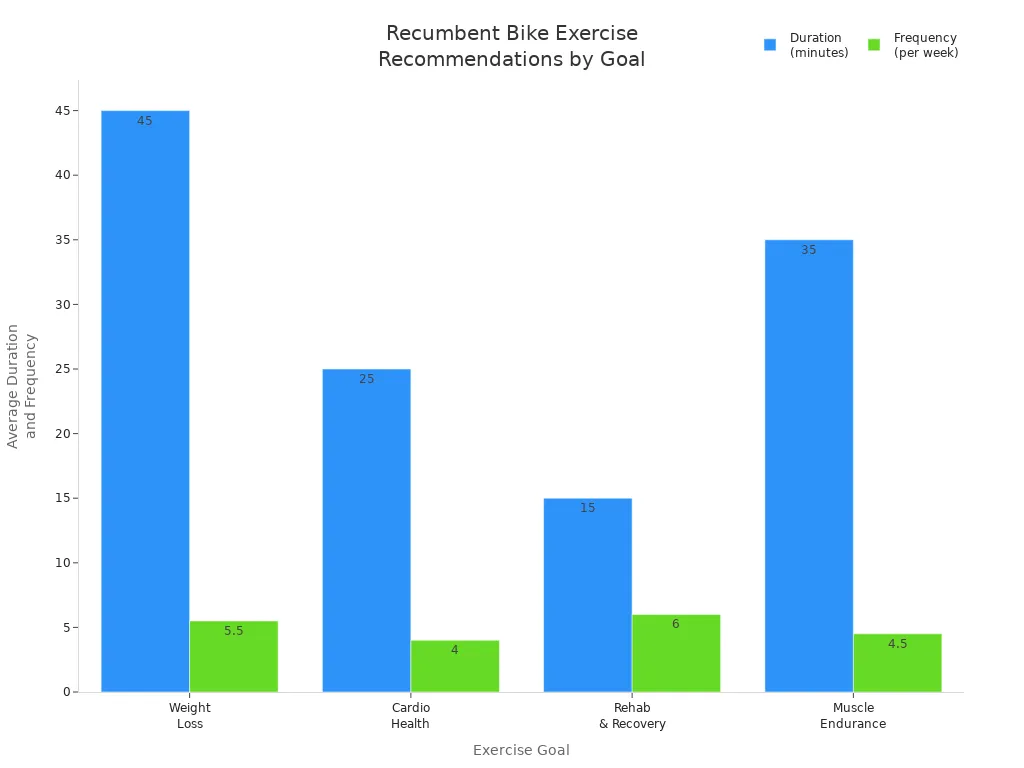
Tip: Start slow and listen to your body. You can increase your time and resistance as you get stronger.
Recumbent Bike vs Upright Bike
Posture Differences
When you compare a recumbent bike to an upright bike, you notice big changes in how you sit and move. On a recumbent bike, you lean back with your legs stretched out in front. The seat feels more like a chair, and your back gets steady support. Upright bikes make you sit up tall, almost like riding a regular bicycle. You need to use your core muscles to keep your balance.
Here’s a quick look at how your body works on each bike:
|
Key Findings |
Upright Bikes |
Recumbent Bikes |
|---|---|---|
|
Muscle Engagement |
More reliance on glutes and hamstrings |
|
|
Cardiovascular Response |
Higher peak heart rate and performance |
Lower peak values, earlier fatigue |
|
Workout Efficiency |
Engages more muscle groups |
More comfort for back issues |
-
Upright bikes help you work your core and keep your posture strong.
-
Recumbent bikes focus more on your glutes and hamstrings. You might slouch if you don’t pay attention.
If you want a bike that feels gentle on your back, recumbent bikes make a great choice, especially for rehab or if you have trouble with balance.
Back Stress
You might worry about back pain when you exercise. A recumbent bike gives your back support and lets you relax while you pedal. You sit back, and the seat takes pressure off your spine. This design helps people with lower back pain feel comfortable and safe.
Upright bikes can make your back hurt more. The seat is smaller, and you have to lean forward. If you have chronic pain, this position can feel unstable. The higher center of gravity on upright bikes may also make you feel wobbly, which is not good for seniors or anyone with back problems.
Tip: If you want to protect your back and your joints, try a recumbent bike. You get a stable ride and less stress on your body.
Best Exercise for Lower Back Pain
Recumbent Bike as an Option
You might wonder what the best exercise for lower back pain is. Many physical therapists recommend recumbent biking because it supports your back and lets your muscles relax. The reclined seat on a recumbent bike helps reduce spinal compression, which can ease discomfort from chronic low back pain. You get gentle cardio that improves blood flow, sending oxygen and nutrients to your spine and muscles. This low-impact movement is great for rehab and recovery, especially for seniors or anyone who wants to reduce stress on joints.
A systematic review found that people who used recumbent bikes in their routines noticed better pain control and improved mobility. If you want a safe way to stay active, recumbent biking is a smart choice. The best recumbent bike for you will have a wide seat, sturdy frame, and easy-to-adjust settings. You can enjoy exercise without worrying about hurting your back.
Other Safe Exercises
You have more options if you want to mix up your routine. Physical therapy experts suggest several active and passive modalities for lower back pain. Here’s a quick table showing what you can try:
|
Exercise Modality |
Type |
|---|---|
|
Back Stretches |
Active |
|
Muscle Strengthening Exercises |
Active |
|
Low-Impact Aerobic Conditioning |
Active |
|
Yoga |
Active |
|
Tai Chi |
Active |
|
Massage |
Passive |
|
Heat and Ice Therapy |
Passive |
You can also try walking, swimming, or gentle stretching. The American College of Physicians recommends yoga, spinal manipulation, and acupuncture for chronic low back pain. Staying active helps your body heal and keeps your joints moving. If you’re in rehab or physical therapy, ask your provider which exercises are safest for you.
Tip: Start slow and listen to your body. You can always add more activities as you get stronger.
Safe Use Tips
Proper Setup
Getting your recumbent bike set up right makes a big difference for your comfort and safety. You want to protect your lower back and get the most out of your workout. Here’s how you can adjust your bike for the best support:
-
Move the seat forward or backward so your knee stays slightly bent (about 10–15°) when the pedal is farthest from you.
-
Make sure your back touches the backrest fully. This helps your spine stay supported and keeps you from rounding or arching your back.
-
Keep your hips level. If your hips rock side to side while you pedal, adjust the seat again.
A good setup helps you avoid pain and makes your ride smoother, especially if you’re using the bike for rehab.
Good Posture
You can prevent lower back pain by paying attention to your posture every time you ride. Try these tips:
-
Set the saddle height so your knee bends just a little at the bottom of each pedal stroke.
-
Adjust the seat so your knee lines up with the ball of your foot when the pedal is at 3 o’clock.
-
Keep your spine neutral and your shoulders relaxed. Don’t slouch or reach too far for the handlebars.
-
Engage your core muscles to help your back stay strong.
-
Warm up before you start and cool down after you finish.
Changing your position during your ride and doing stretches off the bike can also help keep your body feeling good.
Listen to Your Body
Your body gives you signals, so pay attention to them. If you feel pain or discomfort, take a break. Here are some ways to stay safe:
-
Watch your heart rate to make sure you’re not working too hard.
-
Take rest periods to let your muscles recover.
-
Adjust your seat if your knees or back start to hurt.
-
Keep your posture in check to avoid tight shoulders.
-
Strengthen your core to support your back.
-
Take breaks during longer rides to relieve pressure.
Listening to your body helps you avoid injuries and makes your workouts on recumbent bikes safer and more enjoyable.
Benefit from Using Recumbent Bikes
Who Should Use
You might wonder if you can benefit from using recumbent bikes for lower back pain. Many people find these bikes helpful, especially if you want a gentle workout. Here’s a quick look at who gets the most out of this type of exercise:
|
Population |
Benefits |
|---|---|
|
Seniors |
Gentle, low-impact exercise that is easy on the joints, promoting mobility and activity. |
|
Post-Surgery Patients |
Supports recovery by allowing strength rebuilding without excessive strain on surgical sites. |
|
Neurological Conditions |
Provides stability and safety for individuals with balance issues during low-impact workouts. |
If you are a senior, you will find recumbent bikes suitable for seniors because they offer a stable seat and easy step-through design. You get a safe way to stay active. People in rehab or those recovering from surgery also benefit from using recumbent bikes. The bike helps you rebuild strength without putting too much pressure on your back.
When to Avoid
Recumbent bikes work well for most people, but not everyone should use them. If you have certain medical conditions, you should talk to your doctor first. Sometimes, people with severe hip or knee problems may not benefit from using recumbent bikes. If you feel pain while riding, stop right away.
Here are the most common reasons to avoid this bike:
-
You have open wounds or recent surgery that your doctor has not cleared for exercise.
-
You feel sharp pain in your lower back pain or legs during use.
-
Your doctor says you need a different type of rehab.
Always listen to your body. If you feel unsure, ask your healthcare provider before starting a new routine.
You get real comfort and support from a recumbent bike when you set it up right and keep good posture. Always check with your doctor before you start, especially if you have back pain.
-
Your doctor can help decide if cycling fits your needs.
-
Adjust your seat and posture to protect your lower back.
FAQ
Can you use a recumbent bike if you have severe lower back pain?
You should talk to your doctor first. Some people with severe pain need special care. Always listen to your body and stop if you feel sharp pain.
What are the pros and cons of a recumbent bike for back pain?
You get great support and comfort. You may find it easier to exercise. Some people miss the upright bike’s workout intensity. Try both to see what fits you.
Tip: If you want the best recumbent bike, look for a wide seat, sturdy frame, and easy adjustments. These features help you stay comfortable and safe.
Is a recumbent bike better than walking for lower back pain?
You get low-impact exercise with both. Recumbent bikes offer more back support. Walking is simple and free. You can switch between them for variety.
Latest Articles




